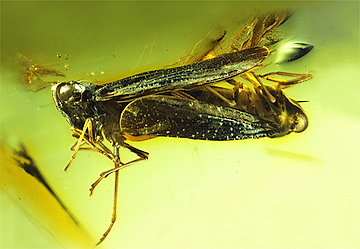Abstract
Nemopteridae are a small family of myrmeleontoid lacewings characterized by elongated ribbon- or thread-like hindwings. Extant Nemopteridae comprise two subfamilies, viz. Crocinae (thread-wings) and Nemopterinae (spoon- and ribbon-wings). They are distributed in all zoogeographical regions except the Nearctic region in the extant fauna. However, the major species diversity of Nemopteridae is confined to the southern part of Africa. The fossil record of the family is scarce, with five Lower Cretaceous fossils, one from the lowermost Cenomanian, two fossils from the Upper Eocene, and two from the Oligocene (Lu et al., 2019; Nel & Jarzembowski, 2019). Here we describe a new, nearly complete fossil from the Oligocene of Lubéron in France. It was found in the Konservat Lagerstätte of Céreste, in finely laminated lacustrine limestones. It is the only specimen of this family found in this outcrop, among more than 30000 fossil insects. Neuroptera are extremely rare in this outcrop; only one adult Ascalaphidae (Ascaloptynx oligocenicus Nel, 1991) and two Mantispidae (Prosagittalata oligocenica Nel, 1988 and an undescribed specimen) have been discovered there (Nel, 1988, 1991).
References
Ábrahám, L. (2014) Contribution to the knowledge of the genus Halter (Neuroptera: Nemopteridae). Natura Somogyiensis, 25, 167–186.
Carpenter, F.M. 1960. Fossil Nemopteridae (Neuroptera). Psyche, 66: 20–24.
https://doi.org/10.1155/1959/25421
Cautru, J.P. & Gigot, P. (1982) L’Oligocène lignitifère du bassin de Manosque-Forcalquier (Alpes-de-Haute-Provence). Etude géologique de la partie nord du bassin (Synclinal d’Apt-Forcalquier). Inventaire des Ressources Nationales de Charbon, BRGM, Rapport, 180 pp.
Engel, M.S., Hinojosa-Diaz, I.A. & Rasnitsyn, A.P. (2009) A honey bee from the Miocene of Nevada and the biogeography of Apis (Hymenoptera: Apidae: Apini). Proceedings of the California Academy of Sciences, (4), 60, 23–38.
Lu, X.M., Wang, B., Yang, S.Y. & Liu, X.Y. (2019) Early evolution of Nemopteridae illuminated with the first and oldest thread-winged lacewing in Cretaceous amber. Systematic Entomology, 44, 262–272.
https://doi.org/10.1111/syen.12328
Makarkin, V.N., Wedmann, S. & Heads, S.W. (2018) A systematic reappraisal of Araripeneuridae (Neuroptera: Myrmeleontoidea), with description of new species from the Lower Cretaceous Crato Formation of Brazil. Cretaceous Research, 84, 600–621.
https://doi.org/10.1016/j.cretres.2017.12.018
Monserrat, V.J., Trivino, V. & Acevedo, F. (2012) Los nemoptéridos y crocidos de la Peninsula Iberica (Insecta: Neuroptera: Nemopteridae, Crocidae). Heteropterus Revista de Entomologia, 12, 231–255.
Nel, A. (1988) Deux nouveaux Mantispidae (Planipennia) fossiles de l’Oligocène du Sud-Est de la France. Neuroptera International, 5, 103–109.
Nel, A. (1991) Nouveaux insectes neuroptéroïdes fossiles de l’Oligocène de France (Neuroptera et Megaloptera). Bulletin du Muséum National d’Histoire Naturelle, Paris, (4), (C), 12, 327–349.
Nel, A. & Jarzembowski, E.A. (2019) New lacewings from the Insect Bed (late Eocene) of the Isle of Wight (Neuroptera: Nemopteridae, Chrysopidae, Hemerobiidae). Earth and Environmental Science Transactions of the Royal Society of Edinburgh.
https://doi.org/10.1017/S1755691018000476
Orfila, R.N. (1954) Un nuevo Nemopteridae americano con una sinopsis de la familia. Revista de la Sociedad Entomologica Argentina, 17, 29–32.
Sole, C.L., Scholtz, C.H., Ball, J.B. & Mansell, M.W. (2013) Phylogeny and biogeography of southern African spoon-winged lacewings (Neuroptera: Nemopteridae: Nemopterinae). Molecular Phylogenetics and Evolution, 66, 360–368.
https://doi.org/10.1016/j.ympev.2012.10.005
Tjeder, B. (1967) Neuroptera-Planipennia. The lace-wings of Southern Africa. 6. Family Nemopteridae. South African Animal Life, 13, 290–501.

